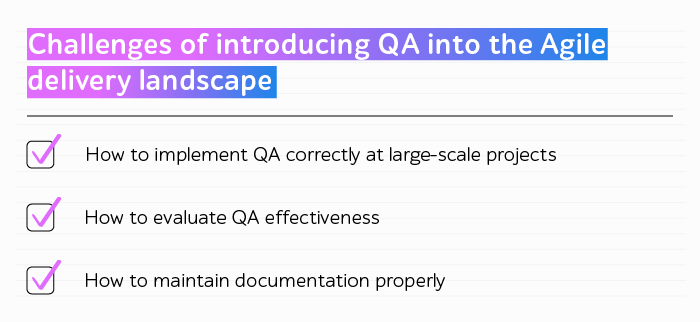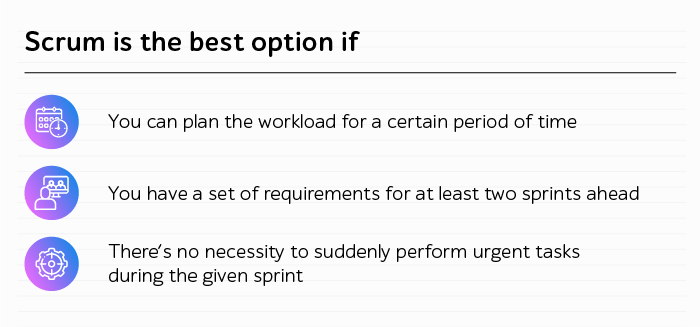
Understanding Agile testing: 6 questions answered
By applying principles of Agile software development, businesses can quickly adapt their products to changing market requirements, increase team motivation, and responsibility for the overall result. Taking advantage of these benefits, teams manage to release high-quality software to the market faster.
However, in the very beginning, the introduction of QA into the Agile delivery landscape may raise some difficulties.

These issues constitute only a small part of all challenging points. We provided the answers to the most common questions regarding the implementation of QA processes based on Agile principles or strengthening the current project course. Let’s check them out.
Does the business domain matter for introducing Agile best practices?
This methodology can be applied to products from any industry, be it BFSI or eCommerce. However, in every domain, the documentation will be detailed differently.
Solutions belonging to the banking sphere are often characterized by complex business logic, and the stakes are too high to let a mistake into production. Therefore, the detailed documentation will eliminate any variations in the sense.
Agile methodology helps prepare testing artifacts and change them gradually if necessary. What are the benefits of such an approach?
Firstly, at the initial stage of product development, you may have a vague idea, with no precise details. Process flexibility will allow you to develop its structure gradually and release without any challenges.
Secondly, with Agile, you can quickly adjust to any market trends. If you want to add new functionality or replace the current one with its more relevant version, you can swiftly add or replace the appropriate part of the documentation.
What are the most common Agile methods?
Agile is a set of principles that provides a unique direction for each project.
Hence, there exists a variety of possible methods. They are similar in many ways and are aimed at synchronizing the work of the team and speeding up product delivery.
The a1qa engineers are mostly involved in projects where product development is carried out according to Scrum/Kanban.
How can one choose the right variant? Have a look at the cases when you can choose Scrum.

As for Kanban, its main difference is the opportunity it gives to quickly switch to unplanned tasks, which changes the sprint length but doesn’t stop the ongoing work. Accordingly, you shouldn’t worry about delayed releases or worsened code quality.
Kanban is a good option for product support, as it allows you to prioritize and resolve emerging problems in the product functioning quickly.
Furthermore, in some cases, the project requires the introduction of Scrum-ban – a combination of the two methods. To ensure high software quality, the development process is carried out applying Scrum, while Kanban is used to support the correct functioning of the product.
Does the team size matter to implement the Agile methodology?
If we are talking about a team consisting of 3-4 specialists, then it’s possible to set up the working processes without resorting to Agile.
With the team of average size (7-9 people), Scrum is one of the best options for organizing the project scope.
However, planning in terms of large groups is quite different. It’s vital to evenly distribute tasks for all team members during the whole sprint.
Can Agile serve a large-scale project?
Certainly. However, it’s important to wisely organize the process and start scaling at once.
We recommend applying SAFe – a framework that helps implement a flexible methodology for large teams (up to 150 people).
To effectively manage such a project, it’s better to split the team into small groups and regularly synchronize their work (after each sprint).
This approach will simplify the project considerably. Smart scaling using the SAFe framework will help you complete all the tasks on time.
a1qa possesses relevant experience. Company’s certified engineers have vast expertise working on projects using Scrum, Kanban, and SAFe methodologies. Regular internal and external training helps the a1qa specialists stay abreast of the latest changes in terms of applying flexible methodologies.
How to measure the effectiveness of the Agile methodology?
It’s vital to keep in mind both the client’s expectations and the chosen method, which differs within each particular project.
If the development process of a product is based on Scrum, then the project will be marked by multiple releases. In this case, the metric demonstrating the overall effectiveness can include the releases frequency and the criteria indicating software readiness.
If the development process is only shifting to Scrum, then the specialists will need time to play well. In such circumstances, the best solution is to focus on the team capacity within one sprint. It should increase over time.
Another metric for assessing quality is the number of defects found in the sprint according to its tasks. It has proven particular efficiency if several teams develop the product. When compiling this metric, each of them is trying to demonstrate the best result during a sprint. Thus, the overall quality is improved significantly.
The number of defects that surfaced the production environment is another metric to consider. Taking into account these defects, you can access the effectiveness of any methodology used on the testing project, not the Agile only.
The core aspect when choosing a metric is to decide on the option to measure and further track its change, for instance, the development speed or the quality of bug fixing.
What is the influence of the Agile methodology over the quality of R&D processes?
We believe the development process benefits from the introduction of the Agile practice.
Scrum implies that at the end of the sprint, the QA team runs regression tests and makes sure the product is ready for release, while the Dev team eliminates technical debt and searches for new and effective coding solutions.
Speaking of the SAFe framework, every fifth sprint, while the QA team is finalizing the tests, the developers dedicate their time to exploration and innovation to optimize their resources, infrastructure, introduce new tools and practices.
This iteration is also the time to perform cross-team knowledge sharing, prepare tools to enhance testing activities, or to focus on any other activity that is hard to fit into a continuous delivery workflow.
Have some questions on the Agile testing left? Ask them to the a1qa experts.








